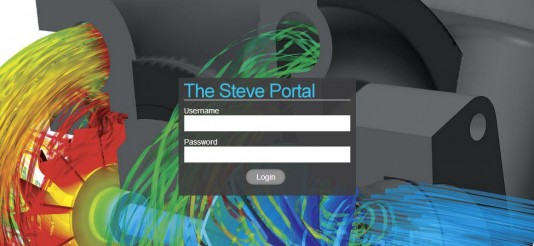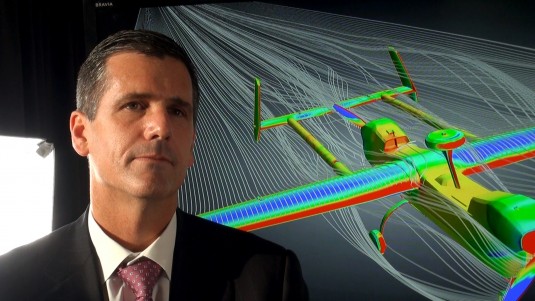STAR-CCM+ seeks to unify FEA and CFD in a single platform.
By Tom Lansford
CADplace
Special to GraphicSpeak
Unlike its competition, the annual CD-adapco customer conference (STAR Global Conference) is heavy on technology and light on marketing. This year, without fanfare, CEO Steve MacDonald announced a common platform for finite flow and finite element simulation, concluding “I think that’s an exciting thing that is coming along …”
In a keynote lasting less than ten minutes, CEO Steve MacDonald laid out the company priorities (reinvestment in development), talked about his priority (local teams in every business region), and then made the major announcement of the conference in an almost off-hand way.

CD-adapco is the largest independent developer of simulation tools for engineering and design. It’s also a closely held private company. In a world where direct competitors include publicly traded companies with access to market capital, open source solutions, and CAD companies integrating simulation into their design suite offerings, you could be forgiven for wondering how this company survives, much less thrives.
STAR Global Conference keynote
The message from MacDonald included the major company announcement that STAR-CCM+ will include both finite flow and finite volume features in a single code base. The company is already focused on multi-disciplinary simulation in a single platform, so this move is a natural strategic direction. Keeping with his frank and honest approach, MacDonald said, “it’s going to be hard to support, but we think that we can do it.”

MacDonald also described the company’s business strategy and direction. It is a $200 million company and the company is re-investing in R&D to drive future product innovation. As CEO, his personal priority is developing the CD-adapco teams around the globe. The company wants customers will be supported directly by CD-adapco. Yes, this is the opposite approach to many engineering software companies today, but it is a key point for the company strategy.
After the brief CEO keynote, the next two keynote addresses did not produce a stream of customer success testimonials or videos filled with all of the great things the company products create. No, they went straight to the topics of interest to attendees: product enhancements coming in 2014 and 2015; how to get information and support; and how to propose enhancements and new features.
The three-day STAR Global Conference was long on content and short on marketing. The schedule for conference sessions included experts from industry, research, and education discussing disciplines from automotive, aerospace, marine, electrical, chemical, and building industries. You could hear about ship roll damping, or simulate a high-tech operating room, or learn about the aerodynamics of the Can Am Spyder 3-wheel motorbike. Daimler, BMW, Jaguar, Volkswagen, Alstrom, Bombadier, Philips, Samsung, and Areva are examples of the companies presenting. Universities from around the globe presented their work as well.
The STAR-CCM+ ecosystem of partners were also present with companies presenting cloud services, simulation consulting, specialized simulation applications, design exploration tools, and HPC server solutions. The partners highlight an important market influence driving the 15% annual growth-rate at CD-adapco. More computing power is available at lower costs to companies—on premise and in the cloud.
CD-adapco business, strategy and competition
I had the opportunity to discuss CD-adapco’s business with Executive Vice President Bill Clark. He conveyed the core focus of the company throughout a discussion of topics including business, growth, product development, and competition.
Regarding the company’s keys to success, CD-adapco is invested in the success of their customers. The company strives to ensure that their customers are supported and successful with the use of STAR-CCM+. The company seems to have added its own control mechanism to ensure that they live up to this standard. CD-adapco only sells annual licenses and refuses to sell perpetual licenses of its simulation tools. Since the company has maintained a growth rate in the double-digits over many years, this would indicate the strategy has worked well for both customers and the company.
Another key to success has been innovation in how the company provides access to its technologies. As companies have changed their infrastructure for HPC and simulation, CD-adapco saw how the number of cores for a simulation was often the limiting factor for customer success.
The company first implemented a licensing called Power Sessions which allows simulations on an unlimited number of cores. Since not all customers needed unlimited cores all the time, the company followed Power Sessions with Power on Demand which allows customers to purchase time on Power Sessions—something particularly useful for peak-demand during a project.
And finally, with the development of Multi-Disciplinary Design Exploration, or MDX, customer licensing flexibility changed again, and CD-adapco introduced the concept of Power Tokens which allow a customer to distribute one or more simulations over one or more computing cores and to include the full suite of design exploration tools. Power Tokens provide customers with a simple method of adapting their use of CD-adapco’s technologies to meet the demands of any project.
Servicing multiple industries
Deryl Snyder is director for the aerospace and defense sector. He is responsible for ensuring the company understands the requirements of the industry and is able to provide the necessary technologies to meet the industry’s needs. At the STAR Global Conference in Vienna, the company announced the delivery of a strong icing simulation capability. It allows STAR-CCM+ to simulate icing from the early stages, through accretion of the ice, to the performance degradation that occurs.
And therein lies the benefit. Typically, a customer follows a segmented workflow. For example, one simulation code for the airflow, another for the ice particles, and another to build the ice on the geometry.
CD-adapco offers a much faster process. With one tool, one model, and one process, it improves efficiency and removes the need to switch between simulation codes. It also helps to reduce errors in the process which can come, for example, from mapping data from one code to another.
Snyder wants his customers to understand STAR-CCM+ is a tool with broad capabilities to address the range of problems they will face such as ice modeling, aerodynamic performance, or passenger comfort. And it provides these capabilities in a single, integrated environment using a single model.
Future product features and development
When it comes to developing simulation capabilities for their customers, CD-adapco has a two-pronged approach. Using their industry experience, the company drives technology which customers will need. And using input from clients, the company implements customer demands. The latter comes through the IdeaStorm Portal, a forum where customers and propose their feature ideas and comment on those of others. Due to IdeaStorm, hundreds of features have been implemented, are in development, or been approved for implementation.
It is equally important to communicate to customers the features which are available, help them use the product, and inform customers about future features. For this CD-adapco uses their Steve Portal (they call the portal Steve) which supplies tutorials, FAQs, product release notes and all types of product information in multiple languages. It also serves as a portal for customers to submit and manage their support issues and training programs.

STAR-CCM+ product manager, Joel Davison, states that many of the features coming in 2014 and 2015 will support multi-discipline design exploration and will build on the ability to support simulating systems. In addition to integrating HEEDS technology into STAR-CCM+, the company will add a co-simulation API as well. By developing an eco-system around the product, STAR-CCM+ customers will have the ability to integrate many technologies. This supports multi-disciplinary design optimization and extends the ability to simulate systems in a single platform. These features will be critical as the company executes on its promise to deliver both finite volume and finite element modeling in a single platform next year.
The key to success for CD-adapco
STAR-CCM+ competes successfully in a demanding market where consolidation has been occurring, and competition comes from every direction. It is not self-evident that CD-adapco could have grown at 13% to 15% per year during recent years.
One competitor, Ansys, leveraged access to market capital to acquire two directly competitive products. Another direct competitor, from the opposite end of the spectrum, OpenFOAM, is an open-source simulation tool. In a market where your customers are leading technical experts in their own fields, an open-source solution is a compelling option.
Traditional CAD companies like Autodesk and Dassault have purchased simulation products and integrated them into CAD design suites. This approach captures simulation customers upstream at the design and modeling decision with simulation capabilities as “part of the package.”
Why is CD-adapco successful?
From my observations, the company achieves its business objective in three ways. It provides excellent customer support, it advances the simulation technology for its clients, and it leverages its status as a privately held company. All three are connected and reinforce one another.
Objectively, the company has numerous support, training and customer-care mechanisms in place. The online Steve Portal and IdeaStorm innovation forum are two recent examples. The company also provides customers with dedicated support engineers. This goes hand in hand with the policy of having CD-adapco employees around the globe rather than agents. This support structure not only helps make customers successful today, it provides the feedback loop for new development.
The company is also focused on driving the technology of their product. Reinforcing Steve MacDonald’s statement, Clark confirmed the company reinvests 35% to 40% of revenue into product development. The company has a track record of three product releases per year. Adding a co-simulation API and the MDX capability supports the company drive to make the latest technologies available to customers—even if the technology comes from another source.

Conventional wisdom might dictate a privately held company has a competitive disadvantage in the market. CD-adapco turns that idea on its head. Free from the constraint of “returning shareholder value,” the company has room to maneuver in the best interest of its business.
MacDonald says the company is not extremely profitable, but profitable. This statement exposes the truth about CD-adapco’s competitive advantage. They reinvest in product development. They build local teams around the globe. They treat customer service and consulting not as a profit center but as a service. They build the positive feedback loop between intimate customer-care and product development to create success for their customers and success for the company.
A simple observation how CD-adapco leverages the private company status can also be seen in the licensing model which is annual and not perpetual – even though some customers request perpetual licenses. This choice reduces the immediate revenue stream at any given moment since annual licenses provide less revenue than perpetual licenses – a strategy which would hardly be acceptable for a public company. On the other hand, this policy reinforces the company commitment to the customer’s success and is a successful competitive strategy.
Tom Lansford has been working in the professional graphics market for more than 25 years. CADplace provides information on the CAD and professional design market In German, French and English. Visit www.cadplace.co.uk, www.cadplace.fr, and www.cadplace.de.





